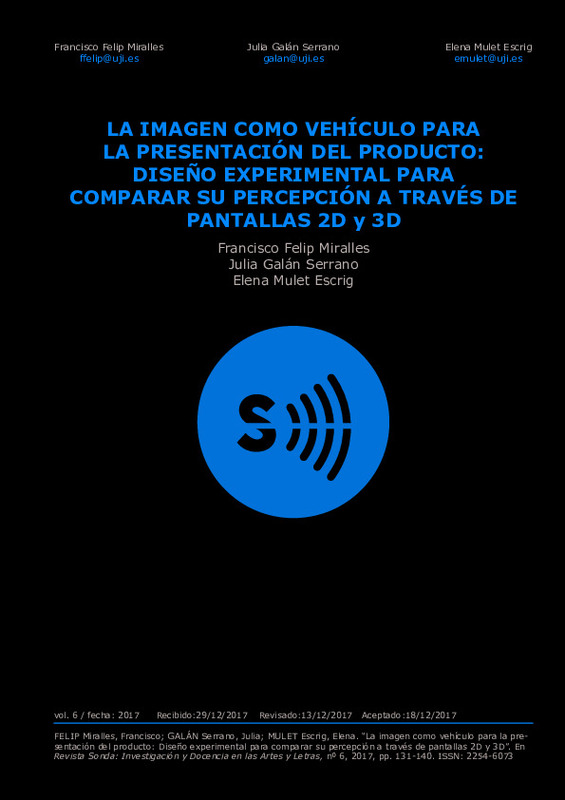- RiuNet repositorio UPV
- :
- Investigación
- :
- Material investigación. Editorial UPV
- :
- Revistas UPV. Editorial UPV
- :
- Revista Sonda: Investigación en Artes y Letras
- :
- Revista Sonda: Investigación y Docencia en Artes y Letras - Vol. 06 (2017): Consecuencias del auge de la Cultura Visual. Diversidad en la creación y en la investigación plástica
- :
- Ver ítem
JavaScript is disabled for your browser. Some features of this site may not work without it.
Buscar en RiuNet
Listar
Mi cuenta
Estadísticas
Ayuda RiuNet
Admin. UPV
La imagen como vehículo para la presentación del producto: diseño experimental para comparar su percepción a través de pantallas 2D y 3D
Mostrar el registro completo del ítem
Felip Miralles, F.; Galán Serrano, J.; Mulet Escrig, E. (2017). La imagen como vehículo para la presentación del producto: diseño experimental para comparar su percepción a través de pantallas 2D y 3D. Revista Sonda: Investigación y Docencia en Artes y Letras. 6:131-140. https://doi.org/10.4995/sonda.2017.18383
Por favor, use este identificador para citar o enlazar este ítem: http://hdl.handle.net/10251/192339
Ficheros en el ítem
Metadatos del ítem
| Título: | La imagen como vehículo para la presentación del producto: diseño experimental para comparar su percepción a través de pantallas 2D y 3D | |
| Otro titulo: |
|
|
| Autor: | Felip Miralles, Francisco Galán Serrano, Julia Mulet Escrig, Elena | |
| Fecha difusión: |
|
|
| Resumen: |
[EN] In a scenario where different display technologies coexist, it is of interest for designers and publicists to know how to prepare the images in each case to make them more effective when presenting a product visually. ...[+]
[ES] En un escenario donde coexisten distintas tecnologías de pantalla, resulta de interés para diseñadores y publicistas saber cómo preparar las imágenes en cada caso para que resulten más eficaces a la hora de presentar ...[+]
|
|
| Palabras clave: |
|
|
| Derechos de uso: | Reconocimiento - No comercial - Sin obra derivada (by-nc-nd) | |
| Fuente: |
|
|
| DOI: |
|
|
| Editorial: |
|
|
| Versión del editor: | https://doi.org/10.4995/sonda.2017.18383 | |
| Código del Proyecto: |
|
|
| Agradecimientos: |
El presente trabajo forma parte del proyecto “Gaming technologies for digital content creation, management, visualization and sonification” (2017-2019, referencia TIN2016-75866-C3-1-R), subvencionado por el Ministerio de ...[+]
|
|
| Tipo: |
|








